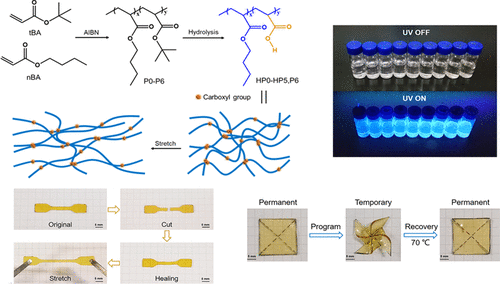当前位置:
X-MOL 学术
›
ACS Appl. Mater. Interfaces
›
论文详情
Our official English website, www.x-mol.net, welcomes your
feedback! (Note: you will need to create a separate account there.)
Hydrogen Bonding-Derived Healable Polyacrylate Elastomers via On-demand Copolymerization of n-Butyl Acrylate and tert-Butyl Acrylate
ACS Applied Materials & Interfaces ( IF 8.3 ) Pub Date : 2020-10-29 , DOI: 10.1021/acsami.0c13837
Wenyan Wang 1 , Zongxu Liu 1 , Zijian Guo 1 , Junliang Zhang 1 , Chunmei Li 1 , Shuai Qiu 1 , Xingfeng Lei 1 , Qiuyu Zhang 1
ACS Applied Materials & Interfaces ( IF 8.3 ) Pub Date : 2020-10-29 , DOI: 10.1021/acsami.0c13837
Wenyan Wang 1 , Zongxu Liu 1 , Zijian Guo 1 , Junliang Zhang 1 , Chunmei Li 1 , Shuai Qiu 1 , Xingfeng Lei 1 , Qiuyu Zhang 1
Affiliation

|
Achieving a desirable combination of good mechanical properties and healing efficiency is a great challenge in the development of self-healing elastomers. Herein, a class of tough and strong self-healing polyacrylate elastomers (denoted as HPs) was developed simply by free-radical copolymerization of n-butyl acrylate (nBA) and tert-butyl acrylate (tBA) and a subsequent hydrolysis reaction rather than direct copolymerization of nBA and acrylic acid (AA). The tiny difference in reactivity between nBA and tBA makes the structural units of the copolymer easy to control. Precise regulation of molecular composition can be realized just by varying the relative monomer content, making its mechanical properties to vary from ductile to robust. Strikingly, when HP samples are cut off within the gauge length, they can heal into coherent and smooth samples and recover at least 79% of the original strength. Hydrogen bond interactions serve as physical cross-linking points, contributing to the high mechanical performance (fracture energy of up to 73.78 MJ·m–3 and tensile strength of up to 17.80 MPa) as well as shape memory function. Moreover, the HP samples emit strong fluorescence when exposed to a 365 nm UV lamp and exhibit an aggregation-enhanced emission effect in the state of dissolution.
中文翻译:

通过丙烯酸正丁酯和丙烯酸叔丁酯的按需共聚氢键衍生的可回收聚丙烯酸酯弹性体
实现良好的机械性能和愈合效率的理想组合是自愈弹性体开发中的巨大挑战。在此,简单地通过丙烯酸正丁酯(nBA)和丙烯酸叔丁酯(tBA)的自由基共聚以及随后的水解反应而不是直接水解来开发一类强韧的自修复聚丙烯酸酯弹性体(表示为HP)。 nBA与丙烯酸(AA)的共聚。nBA和tBA之间反应性的微小差异使共聚物的结构单元易于控制。仅通过改变相对单体含量,就可以实现分子组成的精确调节,从而使其机械性能从延展性变为坚固。令人惊讶的是,当HP样品在标距内被切断时,它们可以愈合成连贯而光滑的样本,并恢复至少原始强度的79%。氢键相互作用是物理交联点,有助于提高机械性能(断裂能高达73.78 MJ·m–3,抗拉强度高达17.80 MPa)以及形状记忆功能。此外,HP样品暴露于365 nm UV灯时会发出强烈的荧光,并在溶解状态下表现出聚集增强的发射效果。
更新日期:2020-11-12
中文翻译:

通过丙烯酸正丁酯和丙烯酸叔丁酯的按需共聚氢键衍生的可回收聚丙烯酸酯弹性体
实现良好的机械性能和愈合效率的理想组合是自愈弹性体开发中的巨大挑战。在此,简单地通过丙烯酸正丁酯(nBA)和丙烯酸叔丁酯(tBA)的自由基共聚以及随后的水解反应而不是直接水解来开发一类强韧的自修复聚丙烯酸酯弹性体(表示为HP)。 nBA与丙烯酸(AA)的共聚。nBA和tBA之间反应性的微小差异使共聚物的结构单元易于控制。仅通过改变相对单体含量,就可以实现分子组成的精确调节,从而使其机械性能从延展性变为坚固。令人惊讶的是,当HP样品在标距内被切断时,它们可以愈合成连贯而光滑的样本,并恢复至少原始强度的79%。氢键相互作用是物理交联点,有助于提高机械性能(断裂能高达73.78 MJ·m–3,抗拉强度高达17.80 MPa)以及形状记忆功能。此外,HP样品暴露于365 nm UV灯时会发出强烈的荧光,并在溶解状态下表现出聚集增强的发射效果。































 京公网安备 11010802027423号
京公网安备 11010802027423号